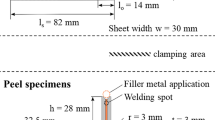Abstract
Alclad aluminum 3005, intended for use in a radiator tube, was evaluated to identify its tensile strength, fatigue behavior, and microstructure. The material consists of an AA3005 core, an AA4343 clad (outer side), and an AA7072 (inner side). To determine the effect of the brazing process, Al alloys before brazing and after brazing were examined with SEM, EDS and nanoindentation tests. Tensile tests were performed to estimate the fatigue behavior. And fatigue tests were performed under constant load amplitudes with mean loads. The mean stress effect on the fatigue behavior of the brazed aluminum was found to correlate well with the Smith-Watson-Topper relation.
Similar content being viewed by others
References
X. X. Yao et al., Strain-controlled fatigue of a braze clad Al-Mn-Mg alloy at room temperature and at 75 and 180°C, Materials Science and Engineering A, 267 (1999) 1–6.
D. M. Turriff, S. F. Corbin and M. Kozdras, Diffusional solidification phenomena in clad aluminum automotive braze sheet, Acta Material, 58 (2010) 1332–1341.
W. S. Miller et al., Recent development in aluminum alloys for the automotive industry, Materials Science and Engineering A, 280 (2000) 37–49.
Y. Hisatomi, Recent advance of brazing sheet and flux for aluminum brazing, Journal of Light Metal welding & Construction, 45 (2007) 413–419.
J. P. Jung et al., Brazing technology and trend in Japan (1), Journal of KWS, 12 (1994).
K.-S. Lee and J.-H. Song, Estimation methods for strain-life fatigue properties from hardness, International Journal of Fatigue, 28 (2006) 386–400.
K. N. Smith, P. Watson and T. H. Topper, A stress-strain function for the fatigue of metals, Journal of Materials, 5 (1970) 767–778.
T. Nicholas and J. R. Zuiker, On the use of the Goodman diagram for high cycle fatigue design, International Journal of Fracture, 80 (1996) 219–235.
J. A. Bannatine, J. J. Comer and J. L. Handrock, Fundamentals of Metal Fatigue Analysis, Prentice Hall (1990).
Author information
Authors and Affiliations
Corresponding author
Additional information
Recommended by Guest Editor Dong-Ho Bae
Soon-Bok Lee received his Ph.D. from Stanford University in 1980. He is currently a Professor in the Mechanical Engineering Department of KAIST. His research interests include reliability in electronics packaging and thin film, elevated temperature materials, fatigue and fracture. He is a member of KSME, KORAS, ASME, IEEE, and SEM.
Hyun-Ho Kim received his B.S. and M.S. degrees from KAIST. He is currently in the doctoral program in Mechanical Engineering Department of KAIST. His research interests include reliability, low and high cycle fatigue, fatigue crack growth and thermomechanical fatigue of structural materials.
Rights and permissions
About this article
Cite this article
Kim, HH., Lee, SB. Effect of a brazing process on mechanical and fatigue behavior of alclad aluminum 3005. J Mech Sci Technol 26, 2111–2115 (2012). https://doi.org/10.1007/s12206-012-0525-1
Received:
Revised:
Accepted:
Published:
Issue Date:
DOI: https://doi.org/10.1007/s12206-012-0525-1




